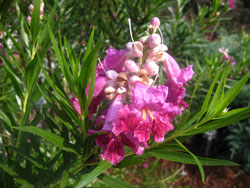Resource Library
Plant of the Week: Willow, Desert
The University of Arkansas System Division of Agriculture does not promote, support or recommend plants featured in "Plant of the Week." Please consult your local Extension office for plants suitable for your region.
Plant of the Week
Desert Willow
Latin: Chilopsis linearis

In a temperate climate, most of our native trees are spring bloomers. This cycle of flowering, and most importantly - at least from the tree’s standpoint - seed production, optimizes the chances of successful reproduction. Summer flowering plants often come from climates where a monsoonal weather pattern prevails, and most of the rainfall comes during the summer months. Such is the case with desert willow, Chilopsis linearis, a native of our southwestern deserts.
Desert willow is not a true willow, but a member of the Bignonia family that contains vines such as trumpet creeper, or trees such as catalpa. Desert willow is a large, sprawling deciduous shrub or small tree capable of growing 25 feet tall with a spread of that or more. It is usually a low-branched, multiple-trunked plant, which leafs out late in the season and produces long, shining green, willow-like leaves to six inches long.
The flowers of desert willow are 1 ½ inch-long, trumpet-shaped blooms with broadly lipped, showy petals borne at the ends of the branches in multiple-flowered panicles containing 20 or more blooms. The sweetly scented flowers are variable in color but mostly center around shades of pink, lavender or purple, often with white or yellow throats. The color range does include forms with pure white flowers to near red. If two plants are present for pollination, slender 6 inch-long bean pods will be produced and hang on the plant during the winter.
The Latin name is taken from the Greek word “cheilos,” which means “lip,” a reference to the broad lips of the flower that give the bloom an almost orchid-like look.
Desert willow is appropriately named because it grows in the arroyos (the Spanish word for creek) in the southwestern states from west Texas to southern California and adjacent areas in Mexico. This part of our country typically receives between 10 to 15 inches of rainfall a year, with much of it coming during the summer months as moisture off of the Pacific is pushed inland and sets up a monsoonal rainfall pattern.
These summer rains are often spotty in the desert, but where they hit the water comes hard and fast. Much of this water runs off into the arroyos where the desert willow lives, occupying a similar environmental niche as the true willows (Salix) along streams in wetter environs. Flowers are produced on new growth, so it is not uncommon to have two or three flushes of growth and flowering even in the seemingly parched desert as water runs past in the arroyo. In a wetter climate, flowers are produced more or less continually from late May until late summer.
Desert willow is cold hardy to at least zero degrees Fahrenheit (zone 7), though it can survive in colder climates as a freeze-and-regrow shrub. It is sensitive to winter-wet sites, so should be planted in soils with especially good drainage. It tolerates a broad range of soil pHs, growing in both acidic and alkaline sites. I have watched a shrub in a neighbor’s yard for 20 years here in the Ozarks, and though it grows in semi-shade in a heavy clay soil, it survives like a champ. However, it has yet to exceed 6 feet in height, and its contribution to the summertime landscape is modest.
In drier climates, where rainfall is low and supplemental irrigation environmentally unwise, a plant like desert willow is an ideal choice for the garden. In wetter regions it can be grown, but will never become a standout in the summer landscape. It can be used as a specimen in the mixed border or as a small patio tree. Plants propagate easily by cuttings, so several clones are offered by nurserymen, primarily based on flower color differences.
By: Gerald Klingaman, retired
Extension Horticulturist - Ornamentals
Extension News - September 17, 2010
The University of Arkansas System Division of Agriculture does not maintain lists of retail outlets where these plants can be purchased. Please check your local nursery or other retail outlets to ask about the availability of these plants for your growing area.